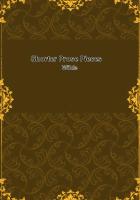Then his wanderings began. He was in an unknown country, without knowledge of the language, and with only a few rupees in his pocket. Presently, however, seeing a light, he proceeded towards it, but only to find himself stopped by a creek. Foiled more than once in this way, he at length arrived at the dwelling of a family of natives, who promptly fled in terror. To inspire confidence and prove that he was mortal, Mr. Spencer threw his coat over the mud wall of the compound, with the result that, after examination of the garment, he was received and cared for in true native fashion, fed with rice and goat's milk, and allowed the use of the verandah to sleep in. He succeeded in communing with the natives by dint of lead pencil sketches and dumb show, and learned, among other things, that he had descended in a little clearing surrounded by woods, and bounded by tidal creeks, which were infested with alligators. Yet, in the end, the waterways befriended him; for, as he was being ferried across, he chanced on his balloon sailing down on the tide, recovered it, and used the tidal waters for the return journey.
The greeting upon his arrival in Calcutta was enthusiastic beyond description from both Europeans and natives. The hero of the adventure was visited by rajahs and notables, who vied with each other in expressions of welcome, in ****** presents, even inviting him to visit the sacred precincts of their zenanas. The promised parachute descent was subsequently successfully made at Cossipore, and then followed a busy, brilliant season, after which the wanderer returned to England.
By September he is in Dublin, and makes the first parachute descent ever witnessed in Ireland; but by November he is in Bombay again, whence, proceeding to Calcutta, he repeats his success of the year before. Next he visits Allahabad, where the same fortune attends him, though his balloon flies away in a temporary escape into the Jumna. By May he is ascending at Singapore, armed here, however, with a cork jacket.
Hence, flushed with success, he repairs to the Dutch Indies, and demonstrates to the Dutch officers the use of the balloon in war. As a natural consequence, he is moved up to the seat of the Achinese War in Sumatra, where, his balloon being moored to the rear of an armoured train, an immediate move is made to the front, and orders are forthwith telephoned from various centres to open fire on the enemy. Mr. Spencer, the while accompanied by an officer, makes a captive ascent, in which for some time he is actually under the enemy's fire. The result of this plucky experiment is a most flattering official report.
In all the above-mentioned ascents he made his own gas without a hitch.
Thence he travels on with the same trusty little 12,000 cubic feet balloon, the same programme, and the same success. This is slightly varied, however, at Kobe, Japan, where his impatient craft fairly breaks away with him, and, soaring high, flies overhead of a man-of-war, and plumps into the water a mile out at sea. But "Smartly" was the word. The ship's crew was beat to quarters, and within one minute a boat was to the rescue. An ascent at Cairo, where he made a parachute descent in sight of the Pyramids and landed in the desert, completed this oriental tour, and home duties necessitated his return to England. Among exploits far too many to enumerate may be mentioned four several occasions when Mr. Percival Spencer has crossed the English Channel.
It fell to the lot of the second son, Arthur, to carry fame into fresh fields. In the year 1897 he visited Australia, taking with him two balloons, one of these being a noble craft of 80,000 cubic feet, considerably larger than any balloon used in England, and the singular fate of this aerial monster is deserving of mention.
Its trial trip in the new country was arranged to take place on Boxing Day in the Melbourne Exhibition ground, and for the lengthy and critical work of inflation the able assistance of British bluejackets was secured. To all appearance, the main difficulties to be provided against were likely to arise simply from a somewhat inadequate supply of gas, and on this account filling commenced as early as 10 a.m. on the morning of the day previous to the exhibition, and was continued till 6 o'clock in the afternoon, by which time the balloon, being about half full, was staved down with sandbags through the night till 4 o'clock the next morning, when the inflation was again proceeded with without hindrance and apparently under favourable conditions. The morning was beautifully fine, warm, brilliant, and still, and so remained until half-past six, when, with startling rapidity, there blew up a sudden squall known in the country as a "Hot Buster," and in two or three minutes' space a terrific wind storm was sweeping the ground.















